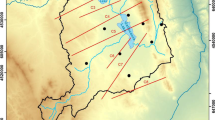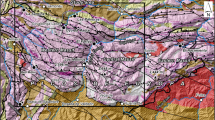Abstract
Water resources management of protected sites requires a powerful tool to analyze the process and changes that are occurring in the environment. This paper describes a 3D geomodel design of the Jarama River Detrital Aquifer located in Madrid (Spain). That hydrogeological unit is included in the “Parque Regional de los Cursos Bajos de los Ríos Manzanares y Jarama” (Regional Park of the Lower Courses of Manzanares and Jarama Rivers). The goal of this work is to define a method by which a three-dimensional (3D) model can be created with hydrogeologic geometry real of main aquifer, to accomplish an adequate management of the groundwater resources. All data used in this study were integrated in a geographic database: geological and hydrogeological information, geological map (1:25,000), eleven cross-sections, piezometric maps and a digital elevation model. The constructed 3D model of the Jarama Aquifer shows geometric features and spatial distribution and variations of geologic units. Thus, the 3D model allows the assessment of volumes of each unit, the depth and thickness variations of the main aquifer, and the spatial and temporal variations of water tables. From the 3D model, the most suitable areas (in terms of groundwater protection) for managed recharge and mining works have been identified.




Similar content being viewed by others

References
Asociación Nacional de Empresarios Fabricantes de Áridos. ANEF (2010). http://www.aridos.org. Accessed 15 December 2010
Bardají I, Cabra P, Calvo JP, Gil de Mingo R, Martín S, Mogrovejo J, Ordóñez S, Sanz E, Sastre A, de Vega MT, Vela A (1990) Estudio para la ordenación de la actividad extractiva en el tramo bajo del río Jarama. Servicio de Estudios y Planificación. Agencia de Medio Ambiente, Comunidad de Madrid
Bonomi T (2009) Database development and 3D modeling of textural variations in heterogeneous, unconsolidated aquifer media: application to the Milan plain. Comput Geosci 35:134–145
Feltrin L, McLellan JG, Oliver NHS (2009) Modelling the giant, Zn–Pb–Ag Century deposit, Queensland, Australia. Comput Geosci 35:108–133
Fernández O, Muñoz JA, Arbués P, Falivene O, Marzo M (2004) Three-dimensional reconstruction of geological surfaces: an example of growth strata and turbidite systems from the Ainsa basin (Pyrenees, Spain). Am Assoc Pet Geol Bull 88(8):1049–1068
Gallerini G, De Donatis M (2009) 3D modeling using geognostic data: the case of the low valley of Foglia river (Italy). Comput Geosci 35:146–164
Le Carlier de Veslud Ch, Cuney M, Lorilleux G, Royera JJ, Jebrakc MJ (2009) 3D modeling of uranium-bearing solution-collapse breccias in Proterozoic sandstones (Athabasca Basin, Canada) Metallogenic interpretations. Comput Geosci 35:92–107
Martelet G, Calcagno P, Gumiaux C, Truffert C, Bitri A, Gapais D, Brun JP (2004) Integrated 3D geophysical and geological modelling of the Hercynian Suture Zone in the Champtoceaux area (South Brittany, France). Tectonophysics 352:117–128
Nury S, Zhu X, Cartwright I, Ailleres L (2009) Aquifer visualization for sustainable water management. Manag Environ Quality: Int J 21(2):253–274
O’Neall M (1999) User manual 3D core builder. Version 3a. Indian Geological Survey
Pérez-González A (1971) Estudio de los procesos de hundimiento en el valle del río Jarama y sus terrazas. Estud Geol 37:317–324
Perrin M, Zhu Z, Rainaud JF, Schneider S (2005) Knowledge-driven applications for geological modelling. J Pet Sci Eng 47:89–104
Silva P, Goy JL, YZazo C (1988) Evolución geomorfológica de la confluencia de los ríos Jarama y Tajuña durante el Cuaternario (Cuenca de Madrid, España). Cuatern Geomorfol 2:125–133
Wycisk P, Hubert T, Gossel W, Neumann Ch (2009) High-resolution 3D spatial modelling of complex geological structures for an environmental risk assessment of abundant mining and industrial megasites. Comput Geosci 35:165–182
Acknowledgments
The authors wish to thank María Bascones and Luis Toribio from the Directorate General for the Environment, Department of Water Quality of the Community of Madrid for his support and the information. They also wish to thank Mercedes Echegaray (Hydrographic Confederation of Tagus River) for this comments and suggestions.
Author information
Authors and Affiliations
Corresponding author
Rights and permissions
About this article
Cite this article
Conde, F.C., Martínez, S.G., Ramos, J.L. et al. Building a 3D geomodel for water resources management: case study in the Regional Park of the lower courses of Manzanares and Jarama Rivers (Madrid, Spain). Environ Earth Sci 71, 61–66 (2014). https://doi.org/10.1007/s12665-013-2694-3
Received:
Accepted:
Published:
Issue Date:
DOI: https://doi.org/10.1007/s12665-013-2694-3



